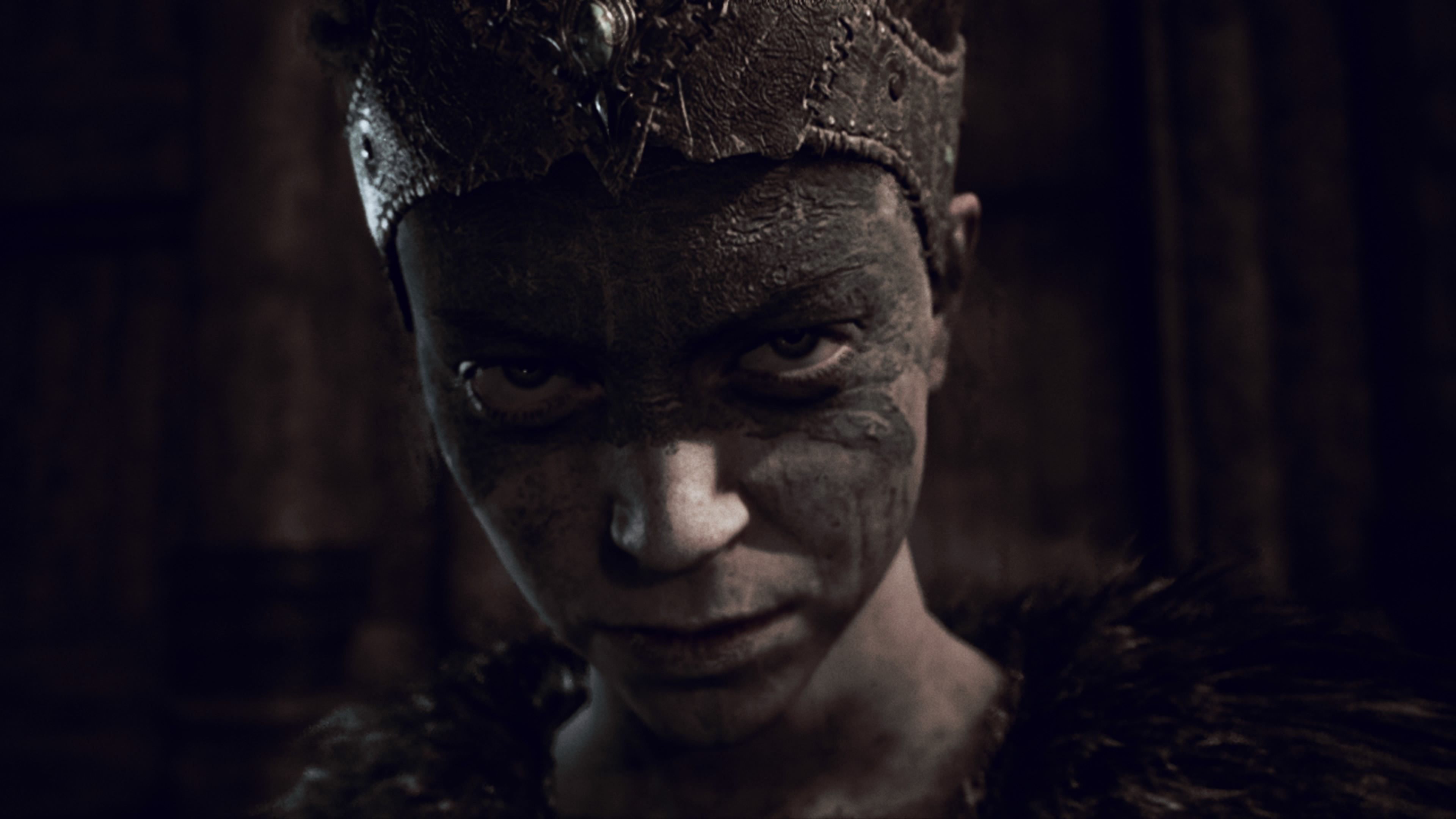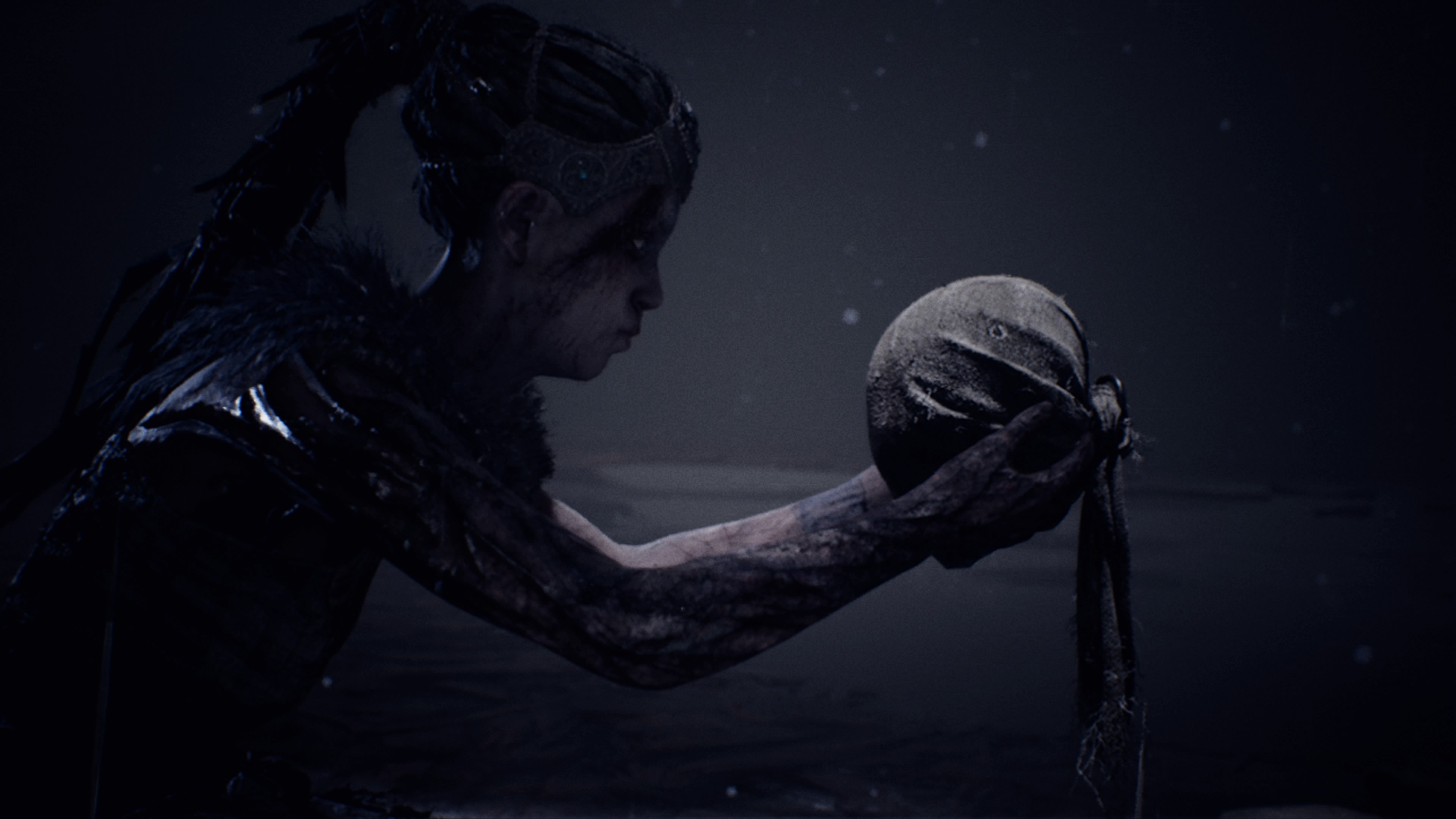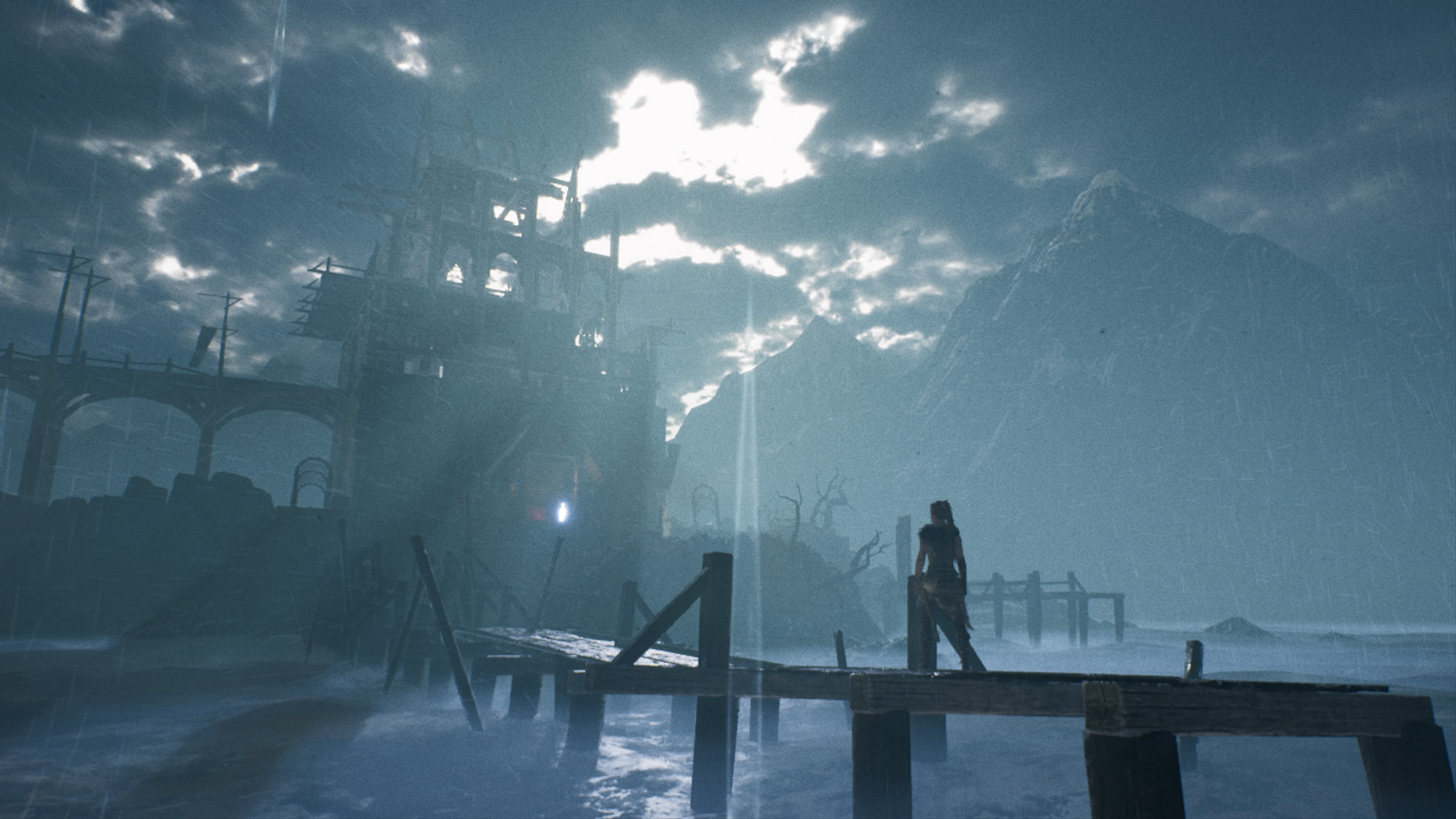She can’t do it……she’s gonna do it……..she’s too weak…….she’s too slow………she’s done it!
As you solely stumble through a staggering series of hardships, you are continually reminded that you are not alone at all. Welcome to the journey of Senua, the tough but tortured soul at the center of Hellblade : Senua’s Sacrifice.

Hellblade is the latest offering from Ninja Theory, the development studio out of Cambridge, England. Originally founded as Just Add Monsters in 2000, they developed an old love of mine in Kung Fu Chaos for the original Xbox. After some financial trouble in 2004, they were signed by Sony to develop Heavenly Sword for the launch of the PlayStation 3. Despite relative critical praise of Heavenly Sword and their following title, Enslaved : Odyssey to the West, Ninja Theory hadn’t seen large mainstream success. Over the past several years they have worked on the Devil May Cry reboot and Disney Infinity, but it was the announcement of Hellblade in 2014 that really piqued the interest of the industry.
Labeled an “Independent AAA game” as the game was developed and published by Ninja Theory themselves, Hellblade was designed to be a “half-length, AAA experience for half the price“. So while it is shorter than most single player experiences today, it nonetheless presents the player with an engrossing narrative and spectacular, varied locations. It is a harrowing journey through the psychosis of the main character Senua. Senua is in a state of grieving over the loss of her love Dillion which has driven her on a path of revenge filled madness. The game centers around Celtic and Norse mythology and has you traveling through Viking filled lands while attempting to reach Hellheim, where you seek an audience with Norse God Hella. Throughout your expedition, you combat enemies who are presumably responsible for the loss of your love and your people. You are often reminded of the atrocities that occurred and at times, will relive them via flashbacks and interactive segments that take place in the past. But in the end, the true journey is had within Senua’s mind.

Throughout your travels to Hellheim and beyond, the voices and personalities in your head will be the only company you have. As Senua, you are on a great voyage to reunite with Dillion. As you relive the horrific events that she and her people experienced, you are given the perspective of a woman who in her heart believes she can truly change the past. But in reality it is a trudge through the deepest recesses of the human psyche. When viewed within that context, this contrast is the area in which Hellblade excels the most especially given the ground breaking work Ninja Theory has done with regard to the sound design.

Right from the outset, as Senua floats her way into hostile territory, the initial opening credit reveals that mental health experts worked with Ninja Theory on the design of the game. As you take your first steps, and are welcomed by bodies on spikes and multiple thoughts from inside your own head, it takes very little time to see why. It’s incredibly difficult to put into words just how accomplished the design of the mental mechanic is in Hellblade. In fact, even describing it as a mechanic feels as though I’m doing a disservice to the development team.
The thoughts haunting Senua’s mind are by far the most integral aspect of Hellblade’s experience and establish a new pinnacle for sound design in this arena. After a short while as Senua, you begin to grow accustomed to having their company. I say their company as Ninja Theory’s use of binaural 3D audio results in the feeling of having multiple people along for your journey, each coming from a specific speaker direction. Beyond being merely atmospheric, it impacts the way you play the game and experience the events that unfold before you. You are warned of threats, offered hints, and perpetually degraded/complemented near simultaneously ; all while the events occurring around you are narrated. It’s a staggering achievement in game design and Hellblade is absolutely a game that should be experienced in surround sound, whether via a home theater or a headset.

Puzzles play a large role in Hellblade and while the implementation is unique, I found the puzzles themselves to be rather mediocre. Puzzles are comprised of a few different style usually involving environmental puzzles that bear a minor resemblance to what we’ve seen in games like The Witness. While they use the environments well, and the visual effects add flair suitable for the title’s lore and art direction, I don’t feel they add any benefit to the game itself. Hellblade could have rather easily presented the same story and themes without the puzzles. You will however find Lorestones (the collectibles in Hellblade) throughout the world that are grounded in Norse mythology. I found these to be rather interesting and a nice addition to the title.

Accentuating your journey are stunning visuals influenced by awe-inspiring artistic direction. As you visit the various Norse inspired locations in the Viking homeland, you are treated to amazing vistas that are both gorgeous and varied. You’ll visit forests, coasts, dungeons, and a host of imaginative, mythological locations. Due to the nature of the game, and the situations it puts you in, lighting plays a significant role and is used extremely well. Combined with a grain filter and a unique graphic method that’s used for your visions and puzzle solving, Hellblade has a very unique look and feel. And while third-person, the camera sits very close behind Senua thus highlighting your point of view ; similar to a first person title. This allows the developers to present environments intimately and I often found myself simply admiring the view. Fortunately, as we’ve seen in several of the recent narrative driven PS4 titles, there is a camera mode which allows you to capture screenshots as you see fit (each of the pictures used in this review were captured from my playthrough).
The visual splendor doesn’t end with just the environments either. Complementing the sustained accent on Senua’s mental degradation, Hellblade uses visual effects in ways I’ve never seen before in a game. While I wouldn’t classify Hellblade as a horror game, there are certainly many evil themes and dark moments which will have you on edge. It’s during these moments where Ninja Theory demonstrates mastery over scene specific lighting, shadowing, and reflections to create a poignant sense of unease. As the primary goal of the title is to highlight a distressed mental state, the art direction and sound design work in unison to accomplish that remarkably well.
A sampling of the stunning visual variety you will find in Hellblade
For reference, if you’re playing on a PS4 Pro, you have the option of running the game in 1080p/60fps or checkerboarded 4K/30fps. After experimenting with each, the fluidity of 60fps felt more natural for Hellblade than the higher resolution. However, you do notice the lack of clarity when compared back to back.
While the visuals and sound design are praise-worthy, the combat sadly leaves a lot to be desired. On the surface, the design is reminiscent of a Soulslike game with quick and heavy strikes, dodges, and parrys which are all directionally driven. The movement and inputs are responsive and would feel at home in a title with much more complex fighting mechanics. However, you soon notice that enemy variety is minimal and their combat designs are rather shallow. It turns into a sequence of figuring out their 2-3 moves and once you’ve done that, it’s incredibly easy to defeat them. It’s rather disappointing as the game more often than not falls into the trap of being a repetitive sequence composed of a walking scene, a puzzle scene, and then a combat scene. The repetition would have been a lot less noticeable had the combat been more fleshed out with more diverse encounters and enemy types.
Thankfully, the boss encounters are not only well designed and unique, but also cinematic. At times they can certainly present a challenge and as they are driven by Senua’s psychosis and memories of horrific events she’s experienced, they each have a theme that is alluded to as you traverse each level. These battles are intense and require your full focus which I found substantially more enjoyable than the combat throughout the rest of my time with Hellblade. The final boss in particular left me with dry eyes and sweaty palms after a several minute battle. Why I wouldn’t call it extremely difficult, it built upon prior themes in the game well and brought them together to construct a formidable, and memorable, final foe.

Unfortunately, Ninja Theory then makes what I consider to be a classic video game design mistake. As you make your final ascent to the game’s climax, you are forced to battle several waves of enemies you had already seen throughout the game ; right through to the final cut scene. This is a design decision we’ve seen in games for decades but thankfully developers have mostly stopped imposing it upon players. So to experience this methodology at the end of Hellblade was certainly a disappointment, particularly just as you are anticipating the culmination of your quest.
Regardless of that frustration, I found Hellblade to be an incredibly interesting and surprising title. From a gameplay perspective, it has shallow combat, unnecessary puzzles, and acts at times as more of a walking simulator. At the same time, it presents a profoundly unique narrative with several design methodologies that deserve substantial praise. My 7 hour journey as Senua was frightening, liberating, harrowing, and memorable all at the same time. Despite being a shorter title, I found myself thinking about it days after finishing it. And even after writing this review, I don’t feel Hellblade is a title that can be accurately summed up with words.

Hellblade is also an important game. The way in which it portrays Senua’s mental conflict is an impactful step forward for the medium. I’m a big proponent of video games representing another art form in which complex themes should be presented, questioned, and discussed. Hellblade does that admirably. For that, I believe Ninja Theory deserves recognition and applause.
Recommended
Hellblade is an ambitious title from Ninja Theory that explores mental health in a way never before seen in video games. It should be experienced.
![]()
@Porshapwr
You can also find our reviews on Open Critic here : Seasoned Gaming
![]()




[…] Just a reminder that you can also find Porshapwr’s review of Hellblade here: Hellblade Review […]
[…] had crafted something truly special. It’s been nearly seven years since Ninja Theory released Hellbade: Senua’s Sacrifice, yet it’s still unique in its presentation and its representation of the impacts of […]
[…] had crafted something truly special. It’s been nearly seven years since Ninja Theory released Hellbade: Senua’s Sacrifice, yet it’s still unique in its presentation and its representation of the impacts of psychosis: an […]